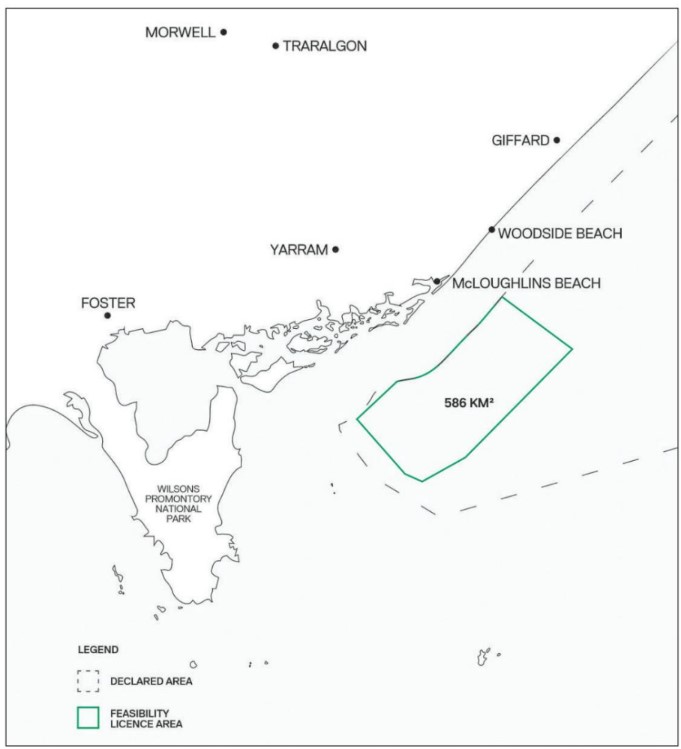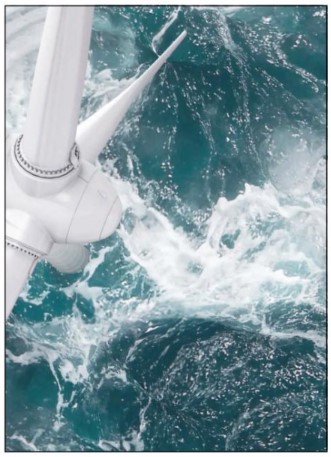Latrobe Valley Express, 7 May 2025
Star of the South is confident of lodging the environmental approval applications this year for its proposed windfarm offshore from Gippsland.
This follows the state government releasing the latest guidelines to implement the offshore wind projects.
Charles Rattray, the chief executive of Southerly Ten, the company behind Star of the South, said the application was based on five years of preparation.
“(It) is backed by a huge body of scientific work including three years studying local marine and bird life, expert advice and technical assessments to ensure Star of the South not only meets environmental requirements but leaves a positive legacy,” he said.
“We’re encouraged by Victoria’s continued commitment to offshore wind energy to boost energy supply and security as Latrobe Valley coal generators retire. Offshore wind is expected to make up five per cent of the National Electricity Market by 2035 so there isn’t a moment to lose. We need offshore wind in the system as soon as possible to meet energy demands and create new regional development and manufacturing opportunities in Gippsland and beyond.”
The state government’s Offshore Wind Energy Implementation Statement 4 (IS4) outlines the next steps towards building 2 gigawatts (GW) of offshore wind energy. To start the auction process, a confidential Registration of Interest (ROI) process started with offshore wind fenability licence holders in March, and will close this month (May). This ROI process will inform the Request for Proposal (RPP) stage later this year.
Star of the South, which aims to build a 2200MW (2.2GW) windfarm off the Gippsland coast at a current estimated cost of $8-10 billion, is looking to forge supply chain links with the Latrobe Valley to source manufacturing parts for the project.
About 200 jobs, likely to be based in South Gippsland, will be needed for operation and maintenance of the windfarm. According to the company, either Barry Beach marine terminal or Port Anthony will be the likely location of the maintenance port. Construction will involve several thousand jobs.
Even after submitting federal and state environmental assessments, Star of the South still has to win an ‘auction’ from the state government to go ahead.
The project is 10 kilometres offshore in a 586 square kilometre zone between Port Albert and Woodside Beach. It would include up to 150 turbines and a transmission system to connect it to the grid.
First power is expected to be produced in about 2030 when the first turbine is installed, with full potential capacity installed by 2032.
The state government has an offshore wind target of 2GW by 2012, 4GW by 2035 and 9GW by 2040 The turbines are certified to operate for 30 years.
The state government’s auction process is expected to begin “soon”, a government spokesman told the [Latrobe Valley] Express. Twelve offshore windfarm licences have been awarded, with all the participants doing their various feasibility studies. The auction will determine who proceeds to the next stage. Star of the South, launched in 2019, is the most advanced.
Southerly Ten has a second project, the KutWut Brataualung-2.2GW windfarm proposed in a 689 area 45km from the tip of Wilsons Promontory-which is at the very start of the development phase. If found to be feasible, it could be ready later in the 2030s.
A successful auction will include a ‘Contract for Difference, which will guarantee a dollar per megawatt figure. If Star of the South falls short of the guaranteed figure, the government will pay the company the difference.
If the company earns more than the guaranteed price, it must pay back the difference to the government.
Once a licence is received after the auction, detailed studies will investigate exactly where turbines will be located. Each of the smaller turbines can produce 15MW of power, but bigger turbines each producing 20MW and up to 350 metres in height are another option.
Once full approvals and finance is completed, construction of the whole wind farm is expected to take four-to-five years. The turbines are built one- at-a-time and connected to the grid one-at-a-time.
Star of the South, as the first ‘cab off the rank’, originally began talking in 2020 with affected farmers and land owners in South Gippsland about their transmission route from the coast to the state grid at the Loy Yang power station. VicGrid has since been created to do that work to create a transmission route for all the offshore windfarms, with a terminal station proposed at Giffard.
Star of the South, to calculate wind availability in Bass Strait, has had a floating wind detector for two years and used the Bureau of Meteorology; the result was very consistent indicating a “strong sweet spot” for offshore wind, the company says. The turbines are robust; they are likely to be turned off in storms less than one per cent of the time.
Building an offshore windfarm is a huge engineering enterprise. Contrary to media reports, at least two ports will be needed for the assembling and construction of the offshore wind. Star of the South says it has been investigating the Port of Hastings, Geelong and Bell Bay ports to see what they can offer. The federal Minister for the Environment, Tanya Plibersek, has vetoed the use of Portland on environmental grounds; Western Port is an international Ramsar site. However, the state government is looking to rework its submission on Hastings and have the federal decision overturned. Star of the South is likely to need two ports – one for the assembly of the turbines and one for the foundations, the company says.
Port Anthony or Barry Beach marine terminal are favoured as the maintenance site due to their proximity to the windfarm site.
After construction, about 200 long-term operation and maintenance jobs are expected to be created in Gippsland. The work would include maintaining the wind farm, marine coordination, project management, and ongoing community engagement. If Kut-wut Brataualung gets up, that could create another 200 long-term operational jobs, the company says.
Ideally, they would be based nearby, although some may travel to site from further afield. It also depends on workforce ability. The company hopes a thriving port will be created, an attractive place to live and work and close to local communities.
The turbines will be manufactured overseas, but Southerly Ten has identified opportunities in steel components for foundations that can be man-made in Australia, including fabrication in the Latrobe Valley. The jewellery’ on the turbines – railings, ladders and other items – sound small, but can add up to hundreds of thousands of tonnes of steel manufactured locally, the start of a potential pipeline of projects, the company says.
The turbines are each certified to have 30-years’ life, although some parts may require replacement as needed. Monthly maintenance is performed throughout the operations.
On a lifecycle analysis, wind farms have been accused of creating large amounts of greenhouse gas emissions during manufacturing. The company acknowledges that transport – to the site, vessels and the fuel they use, and the manufacturing process are key emission sources. However, it maintains that the pay-off period is estimated to be six months’ of operation.
Construction of the wind farm does not use any concrete, a big emissions producer, but only steel, which has a better long-term circulate life than concrete. Concrete is more used around the base of onshore windfarms. Foundations are inserted into the seabed, like a big steel tube.
Mr Rattray, told the [Latrobe Valley] Express that ports are a critical part of any offshore wind project.
“For Star of the South, we expect to use two major ports to support construction, with long-term operations and jobs based out of a local Gippsland port,” he said.
Mr Rattray said the company’s two projects are expected to create around 400 direct Gippsland jobs over the 30-years of operations phase, with further jobs created through the local supply chain. The company was committed to buying locally.
“We’ve been working with local suppliers to understand what’s on offer and found some really exciting opportunities for them to get involved. The steel fabrication work alone is valued at tens of millions of dollars and we know there are several Latrobe Valley businesses who could deliver this,” he said.
Copenhagen Infrastructure Partners, a fund manager and parent of Star of the South, seeks investment around the world to invest in projects. Locally, CBus Super has bought a 10pc stake in Star of the South.
CIP has built wind farms around the world – in Denmark, greater Europe, the US and Asia, a big growth market, particularly in Taiwan, Korea, and Vietnam.


